1930's?? SuperCycle Twin Bar
Hello Everyone, i have started yet another project. This one is an old Super Cycle badged twin bar. Here is what i know about it and i will also let the pictures speak for themselves. Serial number reads A97 93, upon removing the cranks and bottom bracket it read Walton and Brown 285 Made in England. Some of the lugs on the frame also appear to be stamped Made in England as well. After removing a few layers of barn re-paints the original Maroon Enamel with white/cream pin striping was still evident underneath. The rear hub is the only part of both sets of wheels with any manufacturers stampings or markings and appears to be a New Departure Model D. The rear section of the frame from the rear seat stays is also removable at the top by the seat post clamp and also at the rear dropouts of the frame. The twin bars at the top of the frame are also much closer together than what appears on a CCM twin bar frame, also the slope/curve on these tubes is much sharper than that of a CCM.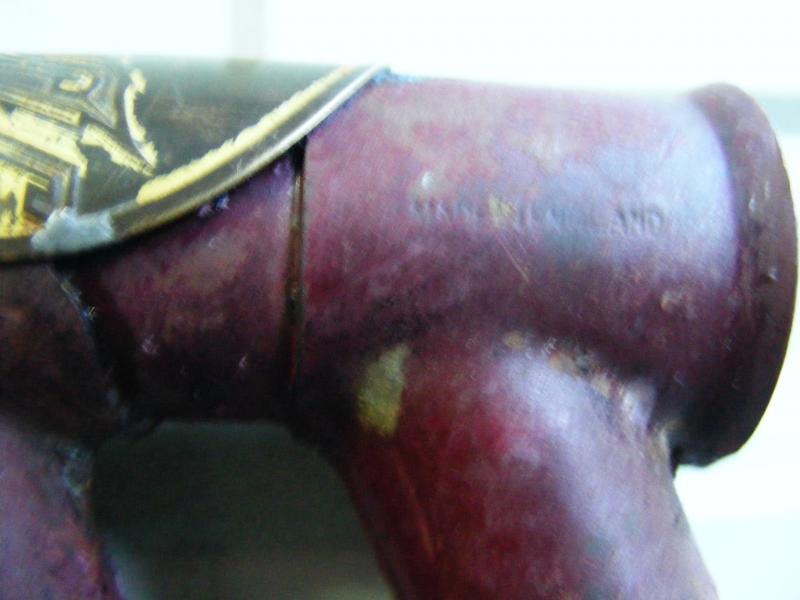
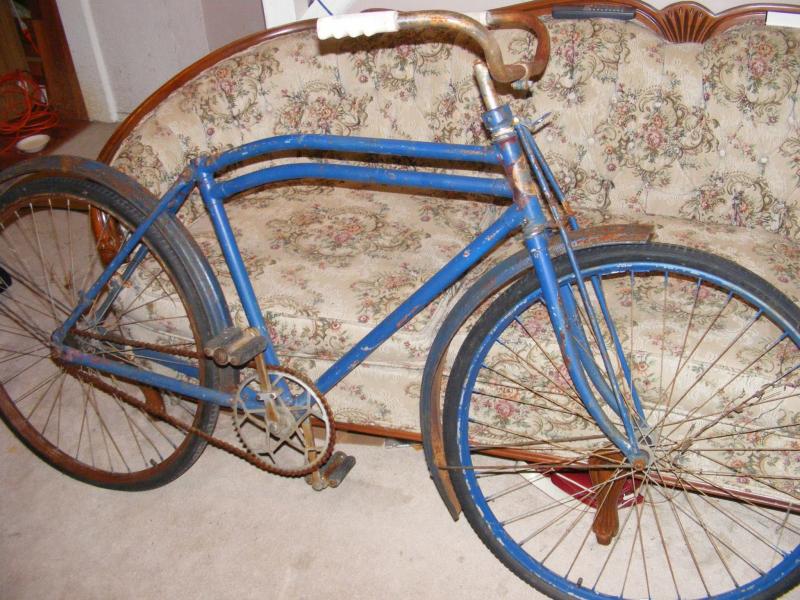
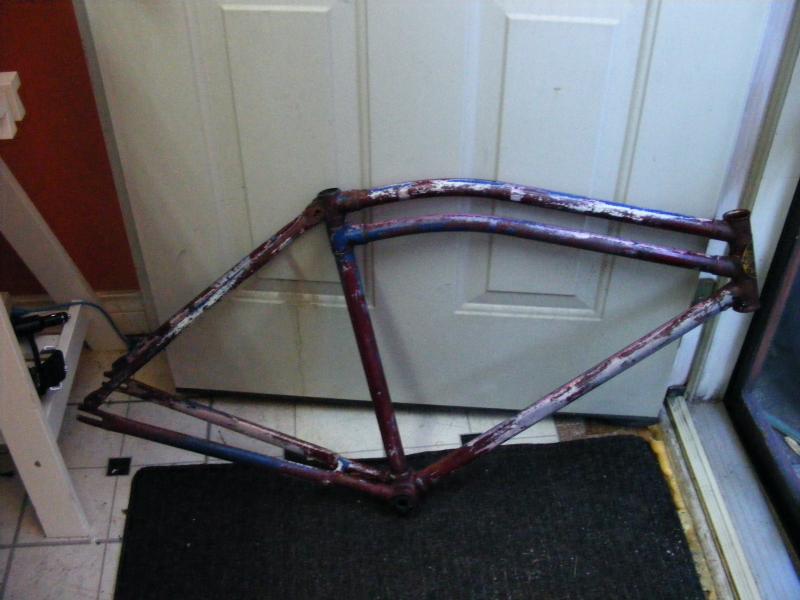
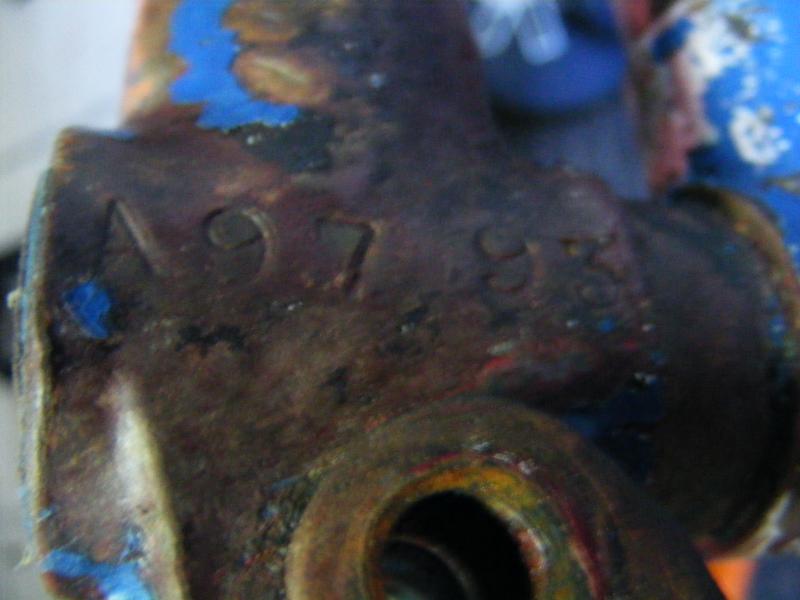
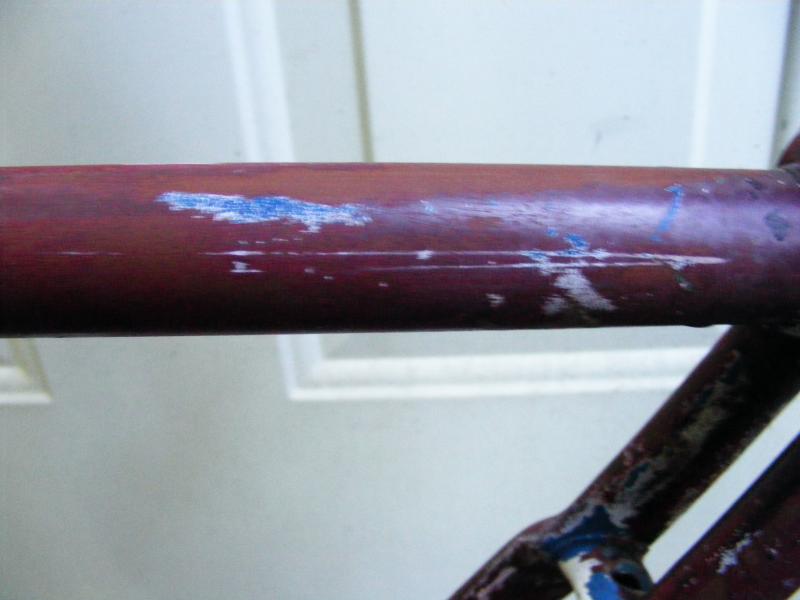
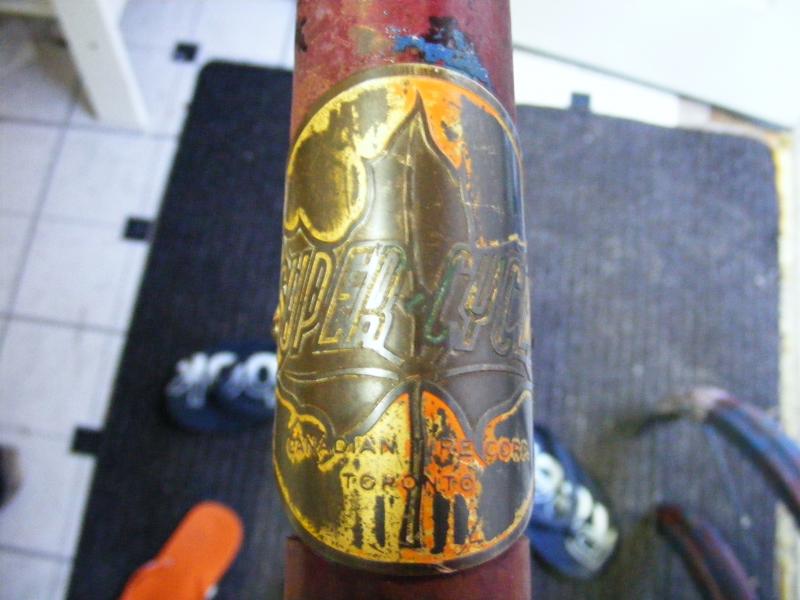
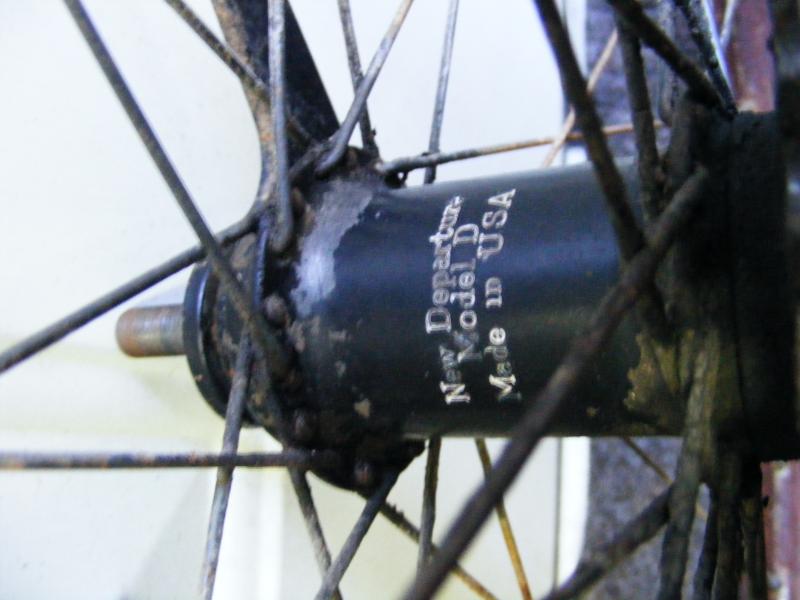
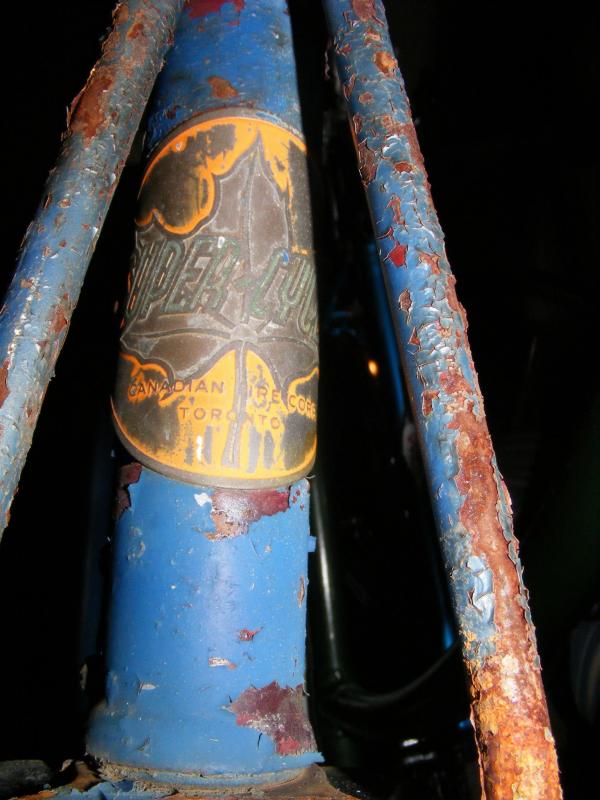 Here are some pics of the project so far, if anyone has any information or can provide me with any means of dating or finding the real manufacturer for this bike it would be greatly appreciated. Thanks in advance for your time and knowledge. Alan.
Here are some pics of the project so far, if anyone has any information or can provide me with any means of dating or finding the real manufacturer for this bike it would be greatly appreciated. Thanks in advance for your time and knowledge. Alan.





that New Departure Model D coaster brake is from the war time period as it's painted instead of nickel plated (I could be wrong, don't take it for granted). I doubt it's original on this bike as it is american and I guess it was built with CCM stuff.
:)
and almost everything is stamped made in England on a Super Cycle badged bicycle, im worried that perhaphs you didn't thoroughly read what i had originally posted. Where is T-Mar when you need him?
My understanding is that the Supercycle brand only goes back as far as 1938 (i,e. 70th anniversary models came out in 2007). So, it should be no older than that.
I must admit that with the exception of the already noted top tube spacing, it does look a lot like a CCM and has a similar serial number format.
Despite the large number of English components, I doubt it is English built. The motorbike frame style seem to have been a North American phenomenom. I have seen perhaps a couple dozen 1930s-1940s catalogs from major English brands (BSA, Elswick, Hercules, Humber, Raleigh) and have not seen a single motorbike. English components and fittings are far more likely on a Canadian built bicycle than USA and Canadian Tire would be far more likely to source from Canada, so it is most likely Canadian.
Another forum member has noted that Standard Cycle Products uded a CCM-style serial number format, so perhaps it is an SCP? It's not typical of the Sunshine serial number format.
As for an upper end to the era, I'd say it is probably not into the 1950s. By then, CCM had dropped the truss fork bracket at the fork crown and most other Canadian manifacturers proably followed suit. Given the apparent era, it's possible it is World War II and those hubs may be OEM.
Awesome, Thanks very much for the information T-Mar. The only reason i have been so sceptical of this bike is because i have CCM twin bar motorbikes and it really does appear to be quite different and unique as far as the typical CCM twin bar style goes.
Also i have tried on a few occasions emailing Canadian Tire and have sent them photo's as well trying to figure out what year this bike is and or just trying to find out any possible information at all on it. After about 4 months of waiting to hear back they never got back to me, so i assume i have stumped them on this one. Again though thanks very much for the Information. It's good to know that the wheels/hubs may be OEM too, so this bike will be getting a complete restoration and hopefully serve as a nice reference to what the Canadian Tire Department store bikes looked like at the time.
Awesome, Thanks very much for the information T-Mar. The only reason i have been so sceptical of this bike is because i have CCM twin bar motorbikes and it really does appear to be quite different and unique as far as the typical CCM twin bar style goes.
Also i have tried on a few occasions emailing Canadian Tire and have sent them photo's as well trying to figure out what year this bike is and or just trying to find out any possible information at all on it. After about 4 months of waiting to hear back they never got back to me, so i assume i have stumped them on this one. Again though thanks very much for the Information. It's good to know that the wheels/hubs may be OEM too, so this bike will be getting a complete restoration and hopefully serve as a nice reference to what the Canadian Tire Department store bikes looked like at the time.
While there aren`t many, there were British made Moto Bikes for the North American market. I`ve had several Eatons Gliders that were Raleigh built. Here`s one of mine...
http://farm8.staticflickr.com/7001/6408344595_f4b529cfb1_b.jpg
Canadian tire used to advertise some of their bikes as built with high grade british tubing. Not sure if they were actually built in Canada or England...
Thanks MERK, when i had stripped most of the paint off the frame i found the "made in England" stamp on most of the lugs that are on the bicycle, so this seems to make a lot of sense.
Thanks for sharing the pic of your Eatons Glider too, i can already see the differences in the frame design. It's not quite like a CCM Tall frame twin bar but still appears to have more of a gap between the 2 matching twin bars. And again it is nice to see some of the other early department store bicycles that where offered other than the CCM's which a lot of us are already familiar with.
There is another question that comes to mind after finding all of this out, where the frames built and made in England? or was the tubing or possibly just the lugs of the frame made in England and then shipped over to Canada for final fabricating and assembly? I find it hard to believe that they may have shipped over a pile of tubes to Canada for final assembly as this seems like it would be not very cost effective but then again who knows?
The question of the source comes down to cost and availability. There are three basic alternatives; in-house manufacture, procuring from a domestic manufacturer or buying from a foreign manufacturer.
During the period in question, CCM was by far the largest Canadian manufacturer. While are no definitive figures, it's generally assumed that CCM's market share was about 85%. The remaining quantity (~15,0000 units per year average), when spilt among the other manufacturers, would almost certainly be insufficient to justify in-house manufacture of lugs, given that apparently even CCM did not do this.
CCM apparently sourced their lugs through an Oshawa based, malleable castings company. The company was not specifically in the bicycle lug business and probably did not catalog a set of bicycle lugs. More likely, CCM funded the development costs for the tooling and had them made to order. It's questionable whether the smaller Canadian bicycle manufacturers would have had sufficient capital for this approach and most would probably have sourced lugs from a foreign source.
The primary foreign sources for lugs would have been the USA and Britain. While the USA was closer, Canada had a far more favourable trade agreement with Britain. The reduced duties appear to have more than offset the shipping costs. When one looks at the CCM catalogs of the era, the Britsh components far outweigh the USA examples. Furthermore, they appear to have been very cost effective, with items like UEK cranksets, Bayliss-Wiley coaster brakes and Phillips pedals being less expensive than their CCM counterparts and subsequently being spec'd on budget CCM brands like Cadet and Cyco. If the British parts were cost effective for CCM's budget brands, there is a high probabllity that British lugs would have been a cost effective alternative for other Canadian manufacturers. Buying British lugs and manufacturing the frame in Canada, would probably result in a more favourable duty rae, than buying a complete frame, as there is more Canadian content (i.e. labour and tubing). I certalnly wouldn't rule out the possibility of a Canadian manufactured frame with British fittings.
While it's irrelevant to the discussion due to it's special nature, it should be noted that CCM used British tubing on it's Flytes and Flyers, employing Accles & Pollack's high strength Kromo (chromium-molybdenum) tubing.
Such a wealth of Information, and you have given me a lot to think about. Thanks very much again T-Mar!
From what I recall the Gliders, which were rebadged Raleigh Sports, were assembled at the Raleigh factory in Quebec. The parts and frames were all shipped in and assembled to avoid the duty charges of complete bikes.
A handy thing for a Canadian trying to restore an old Sports is that the Gliders have the same Raleigh proprietary threading on the bottom bracket and headset (26 tpi). Of course, this also means an old Sports can be used to revive a Glider.
Glider was an Eaton's brand name, not a bicycle model. There were a number of different models produced under the name. While some Gliders may have been produced by Raleigh's Quebec based operation, a large number were sourced elswhere, as this facility did not commence operations until 1972 (some sources say 1973). They eventually went beyond assembly, also manufacturing frames in-houise, Sadly, this facility discontinued manufacturing operatios in June of this year, though it still operates as a sales and distribution centre.
The Canadian Raleighs have a distinctive serial number format. One of the things against the OP's bicycle being contract manufactured by Raleigh (England), is the serial number format. During the period in question, Raleigh used a six character serial number format, while the OP's only has five. Of course, there is always the possibility that it was the 9,793 rd frame from the period or that the gap represents a missing character, however an A-prefix would be incorrect for the era.
T-Mar, thanks for the clarification. The only Gliders I've come across are 70's vintage, and I once even (more or less) restored one: http://drumbent.com/glider.html
Mark, that was a nice article on the Gliderrestoration and very generous of you to donate it to the Co-Op. I myself learned to ride on my sister's Glider. I forget the model but it was just a Lady's or Girl's coaster brake model, probably with 28" wheels. It was blue with white finders and chainguard, and at one point had received a weld repair to the seat tube. While I'm not sure of the exact vintage but it was probably very late 1950s to very early 1960s.
My most memorable moment with the Glider was running into the back of a neighbour's pick-up truck on one of my first two-wheeled riding attempts. The Glider was too big for me and I really had trouble controlling it. Anyway, the neighbour came running out of his workshed and was very concerned about me. These days, the owner would come out screaming about the possible damage to his vehicle and barely give t notice to the cyclist, except to possibly threaten with death or a lawsuit. My neighbour couldn't care less whether I had scratched or dented his truck. Things certainly have changed.
Bu coincicdence, I was looking though a pile of old bicycles yesterday and came across a motorbike with very closely spaced top tubes. However, this was the only similarity to Alan's bicycle. At one time it had been equipped with a stirrup front brake. The head decal said Windsor and the down tube decal stated Winchester. Despite the frame style and brake, I came away with the impression that it was a relatively modern, retro-styled bicycle. On my next visit, I'll have to take my camera and dig it out of the pile, to get a better look.
Allan! This bike has "large balls" (see photo) ...This is a 2 year old post so I'm trying to get your attention. ...Do you have an update on your Supercycle project? I have a Supercycle with the same head tube badge and paint so I thought I'd post photos of it here. It is "as found". The serial number is 95347 and the licence plate says 1947, so that got me wondering if the last 2 digits in the VIN is the year, but that wouldn't work for your bike.
In John McKenty's book he wrote: "By the fifties competition from British makers, Raleigh in particular, had made considerable inroads into CCM's share of the Canadian bicycle market. With both Eaton's and Simpson's importing British bicycles, CCM complained that the English companies could "lay down bicycles in Vancouver and Montreal cheaper than we can from Weston."" ...So this bike shows CCM's competition from Crappy Tire in the '40s but what does one do with it? - put CCM fenders on it and ride it? - part it out and use the bell, wheels, tires, bars, and saddle on my CCMs? I am lacking garage space, so any offers? Should we have an online auction here? I'm only half kidding because I'd hate to part out an all-original bike. Is an early CTC worth anything to anyone?
Photos...
More photos:
P.S. I was bad-mouthing this bike only. Allan's double bar Supercycle is very cool and worth restoring. I forgot to mention this bike also has Made in England stamped on the frame. The front hub is English, the hub brake is American - New Departure, and 36 spokes front and back (2 broken).
Wow, another one found! that's fantastic Brian. Yours too has the new departure model D as well which re-afirms to me that the wheels on mine are still original. My progress on this bike has come to a dead stop and the bike is in pieces residing in my basement. I fell out of interest with it after i realized that it was going to need paint. After painting a few of the old 30's and 40's CCM's i have found that it's rather a large project to take on and i sort of burned myself out on them. Also after aquiring a Flyte i also gave up on a lot of the wartime stuff after that find. The Supercycle on the other hand is one that i do plan on holding onto untill i can find the free time to finally get the ball rolling on this.
My only fear is that i took this bike apart 2 years ago and that i hope i can remember how it all goes back together and where i stored all of the small parts as well as all the loose bearings from the headset and bottom bracket.
Thanks for your interest Brian. Where are you located? if your in the Southern Ontario Area i might be interested in your early Supercycle if your selling. Thanks Alan.
Hi Alan. I know what you mean. I stripped off a crappy repaint once and learned my lesson. Now I stick with original paint bikes whenever possible. I like even rusty original (like my Supercycle). I checked the hub brake and it does say "Model D".
I have a question about your fenders since mine has none. Are they similar in shape to CCM fenders of that era? I have an extra pair that I could put on. Also, I wonder which is more likely, that my bike was sold with no fenders when new since it was a low-cost bike, or that a teenager removerd them to make it look faster and more cool? Anyone on this site who might have some insight on this, your comments are welcome.
I think I will hang on to this bike for a bit longer. Now that I've taken it down from the rafters of the garage, I think I will fix the 2 broken spokes. I does ride nicely. I live in Toronto, downtown. Where in southern Ontario are you?
-Brian R.
Brian:
Waterfall fenders similar to CCM waterfall fenders were used. There were differences in profile in that the centre rise is about 1/8 " wider and the dropside is 1" vice 3/4" on the CCM fenders. In short, you could use the CCM waterfalls and not detract from the original look.
Pics are of mine
Thanks Wayne. I will put on white fenders since I don't want to paint over the original paint on the frame. It's interesting that in this forum there are photos of 3 Supercycles from the same era and each has a different frame design. Do you have an idea about what year your bike was made? 1950s maybe? With the chome accents the headtube badge on yours seems to have a slightly more modern look to it that the one on mine and Alan's (1940s) It's not the same badge, just in better shape, is it?
Don't know the year, don't know much about Supercycles of that era. The detail on all 3 badges is the same. The paint on your head badge and Allen's has faded and oxidized as has the metal. The colours on mine would have been what your background colours had been. It appears that the metal on yours may be brass or oxidized tin, steel???where mine appears to be aluminum, I will have to look at mine next time I go to the cottage.
I studied the 3 photos more closely, and noticed yours has "REG'D" at the bottom. Also, the middle 'o' in Toronto is in a slightly different location. I think the badges are close in years but different. It would be great to find some CTC catalogues from the 40s and 50s to see the models they offered.
Supercycle with CCM fenders. Alan, I've decided that my legs are too short and stubby to ride this tall frame bike comfortably in the stop and go of downtown Toronto. You expressed an interest in buying it. Please email me at brianrreynolds@yahoo.com to discuss further. -Brian R.
Hi All,
Just recived a Super Cycle that I saved from a barn in Southwestern Ontario. No rear wheel unfortunately. Some info that may be of interest to all. The handlebars and stem are blacked-out like the American parts of the same era, such as Morrow and New Departure hubs. The seial no. is A9143. I'm beeswaxing the frame as is, adding CCM V bars, vintage Fichtel Sachs Duomatic 2 spd hub and high flange Campy hub on Velocity Atlas polished. Planning on riding the cottered cranks, as they are good and BB regreased, but may want to add square taper cranks. Would anyone know if a threadless BB shell from Velo Orange or other would work?
Here is a pic...
I have no experience with the Velo Orange threadless bottom bracket, but based on the description it looks like it should work. It certainly is an interesting solution to the problems that plagued earlier threadless bottom brackets.
This sounds like an interesting build. The only thing that I would suggest is that you do not dispose of any of the original equipment. In my experience, the more more radically customized bicycles are a hard sell when it comes time, as the customization is very much a matter of personal taste. It would probaly be much easier to sell and garner a better price with the original parts, especially given that they are war era.
Thanks T-Mar, I will be holding onto the original parts and this one will probably never have a "for sale" sign attached to it! Will post pics once completed.
Supercycle Urban Klunker complete!
I never updated to advise that I went with the YST square taper conversion kit which worked great. Another option if you would like to run a square taper crankset is a BMX BB conversion kit American to Euro 68mm.